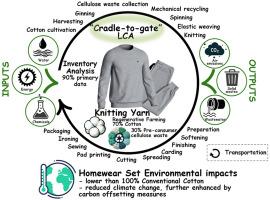Towards circular textiles: Life cycle assessment of homewear produced from regenerative cotton and post-industrial waste versus conventional cotton
IF 10
1区 环境科学与生态学
Q1 ENGINEERING, ENVIRONMENTAL
引用次数: 0
Abstract
The textile industry is a major contributor to global and local environmental impacts, particularly due to high water consumption, greenhouse gas emissions, and land use. These impacts are driven by several factors, most notably cotton cultivation and energy-intensive processes such as spinning and dyeing. To address these sustainability challenges, the Life Cycle Assessment (LCA) methodology provides a comprehensive framework for evaluating products and processes in the textile sector. In this study, LCA is applied to assess the environmental performance of a homewear set produced from a yarn blend consisting of 30 % recycled post-industrial cellulosic waste and 70 % virgin cotton sourced from regenerative agriculture. A comparative analysis was conducted with a similar homewear set composed entirely of conventional cotton, globally sourced and dyed using traditional methods, to assess the potential benefits of using more sustainable materials. The functional unit (FU) is defined as one medium-sized homewear set, consisting of a sweatshirt and pants. The life cycle inventory was primarily based on primary data gathered directly from the manufacturer's supply chain, complemented with secondary data from the literature and recognized databases where necessary. Overall, primary data covered approximately 90 % of the product system. Environmental impacts were assessed using the ReCiPe 2016 (v1.03) method at the midpoint level under the egalitarian perspective, focusing on seven impact categories relevant to the textile sector. Results show that cotton cultivation is the most impactful life cycle stage, contributing 32.0 % to climate change, 92.5 % to water consumption, and 33.9 % to land use. Other significant contributors include knit finishing processes (24.1 % of climate change impact) and spinning (18.9 % of climate change). The homewear set incorporating recycled and regenerative materials demonstrated a 53.9 % lower climate change impact compared to the conventional alternative, increasing to 81.5 % when carbon offsetting in the cotton cultivation stage was considered. Water consumption decreased substantially, from 4.66 m3/FU to 1.54 m3/FU. Despite these improvements, further efforts are needed to reduce fossil energy use and mitigate ecotoxicity. These findings highlight the potential of incorporating recycled content, regenerative agricultural practices, and renewable energy to reduce the environmental footprint of textile products while maintaining quality, thereby supporting sustainability goals and guiding future research and development in sustainable textile production.

迈向循环纺织品:由再生棉和后工业废物与传统棉生产的家居用品的生命周期评估
纺织业是全球和当地环境影响的主要贡献者,特别是由于高用水量,温室气体排放和土地使用。这些影响是由几个因素驱动的,最明显的是棉花种植和纺纱和染色等能源密集型工艺。为了应对这些可持续性挑战,生命周期评估(LCA)方法为评估纺织行业的产品和过程提供了一个全面的框架。在这项研究中,LCA被应用于评估一套家用服装的环境性能,这套服装由30%的回收后工业纤维素废料和70%的再生农业原棉混纺而成。与一套完全由传统棉花组成的类似家居用品进行了比较分析,这些棉花来自全球,并使用传统方法染色,以评估使用更可持续材料的潜在好处。功能单元(FU)被定义为一套中等大小的家装,包括一件运动衫和裤子。生命周期清单主要基于直接从制造商供应链收集的主要数据,必要时补充了文献和公认数据库中的次要数据。总的来说,原始数据覆盖了大约90%的产品系统。在平等主义视角下,使用ReCiPe 2016 (v1.03)方法在中点水平对环境影响进行评估,重点关注与纺织行业相关的七个影响类别。结果表明,棉花种植是影响最大的生命周期阶段,对气候变化的贡献率为32.0%,对水资源消耗的贡献率为92.5%,对土地利用的贡献率为33.9%。其他重要的影响因素包括针织整理工艺(占气候变化影响的24.1%)和纺纱工艺(占气候变化影响的18.9%)。与传统替代品相比,采用回收和再生材料的家居用品对气候变化的影响降低了53.9%,如果考虑到棉花种植阶段的碳抵消,则增加到81.5%。用水量大幅下降,从4.66 m3/FU降至1.54 m3/FU。尽管有这些改进,需要进一步努力减少化石能源的使用和减轻生态毒性。这些发现强调了将回收成分、可再生农业实践和可再生能源结合起来,在保持质量的同时减少纺织品的环境足迹的潜力,从而支持可持续发展目标,并指导未来可持续纺织品生产的研究和开发。
本文章由计算机程序翻译,如有差异,请以英文原文为准。
求助全文
约1分钟内获得全文
求助全文
来源期刊

Journal of Cleaner Production
环境科学-工程:环境
CiteScore
20.40
自引率
9.00%
发文量
4720
审稿时长
111 days
期刊介绍:
The Journal of Cleaner Production is an international, transdisciplinary journal that addresses and discusses theoretical and practical Cleaner Production, Environmental, and Sustainability issues. It aims to help societies become more sustainable by focusing on the concept of 'Cleaner Production', which aims at preventing waste production and increasing efficiencies in energy, water, resources, and human capital use. The journal serves as a platform for corporations, governments, education institutions, regions, and societies to engage in discussions and research related to Cleaner Production, environmental, and sustainability practices.
 求助内容:
求助内容: 应助结果提醒方式:
应助结果提醒方式:


